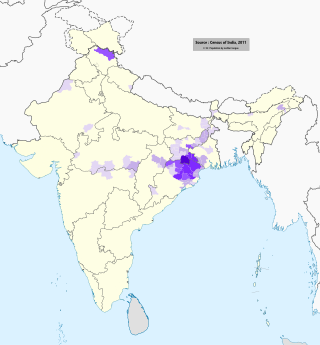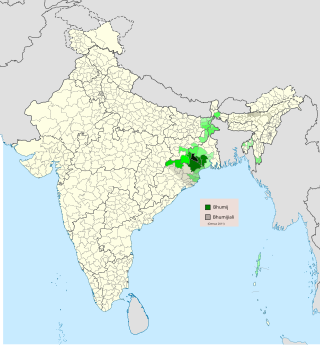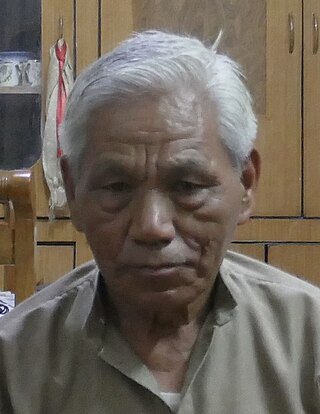Related Research Articles

An endangered language or moribund language is a language that is at risk of disappearing as its speakers die out or shift to speaking other languages. Language loss occurs when the language has no more native speakers and becomes a "dead language". If no one can speak the language at all, it becomes an "extinct language". A dead language may still be studied through recordings or writings, but it is still dead or extinct unless there are fluent speakers. Although languages have always become extinct throughout human history, they are currently dying at an accelerated rate because of globalization, mass migration, cultural replacement, imperialism, neocolonialism and linguicide.

Languages spoken in the Republic of India belong to several language families, the major ones being the Indo-Aryan languages spoken by 78.05% of Indians and the Dravidian languages spoken by 19.64% of Indians; both families together are sometimes known as Indic languages. Languages spoken by the remaining 2.31% of the population belong to the Austroasiatic, Sino–Tibetan, Tai–Kadai, and a few other minor language families and isolates. According to the People's Linguistic Survey of India, India has the second highest number of languages (780), after Papua New Guinea (840). Ethnologue lists a lower number of 456.

Bundeli or Bundelkhandi is an Indo-Aryan language spoken in the Bundelkhand region of central India. It belongs to the Central Indo-Aryan languages and is part of the Western Hindi subgroup.

Santali, also known as Santal or Santhali, is the most widely-spoken language of the Munda subfamily of the Austroasiatic languages, related to Ho and Mundari, spoken mainly in the Indian states of Assam, Bihar, Jharkhand, Mizoram, Odisha, Tripura and West Bengal by Santals. It is a recognised regional language of India as per the Eighth Schedule of the Indian Constitution. It is spoken by around 7.6 million people in India, Bangladesh, Bhutan and Nepal, making it the third most-spoken Austroasiatic language after Vietnamese and Khmer.

Kauravi, also known as Khaṛībolī, is a dialect of Hindustani descended from Shauraseni Prakrit that is mainly spoken in northwestern Uttar Pradesh, outside of Delhi.

Ho is a Munda language of the Austroasiatic language family spoken primarily in India by about 2.2 million people per the 2001 census. It is spoken by the Ho, Munda, Kolha and Kol tribal communities of Jharkhand, Odisha, West Bengal and Assam and is written using Warang Citi script. Devanagari, Latin and Odia script are also used, although native speakers are said to prefer Warang Chiti, invented by Lako Bodra.

Kurukh, also Kurux, Oraon or Uranw, is a North Dravidian language spoken by the Kurukh (Oraon) and Kisan people of East India. It is spoken by about two million people in the Indian states of Jharkhand, Chhattisgarh, Odisha, West Bengal, Assam, Bihar and Tripura, as well as by 65,000 in northern Bangladesh, 28,600 of a dialect called Uranw in Nepal and about 5,000 in Bhutan. The most closely related language to Kurukh is Malto; together with Brahui, all three languages form the North Dravidian branch of the Dravidian language family. It is marked as being in a "vulnerable" state in UNESCO's list of endangered languages. The Kisan dialect has 206,100 speakers as of 2011.

Udham Singh Nagar is a district of Uttarakhand state in northern India. Rudrapur is the district headquarter. The district consists of nine Tehsils named Bajpur, Gadarpur, Jaspur, Kashipur, Khatima, Kichha, Nanakmatta, Rudrapur, Sitarganj. The district is located in the Terai region, and is part of Kumaon Division. It is bounded on the north by Nainital District, on the northeast by Champawat District, on the east by Nepal, and on the south and west by Bareilly, Rampur, Moradabad, Pilibhit and Bijnor District of Uttar Pradesh state. The district was created on 29 September 1995, by Mayawati government out of Nainital District. It is named for freedom fighter and Indian revolutionary Udham Singh.
Ganesh Narayandas Devy is an Indian cultural activist, literary critic and former professor of English. He is known for the People's Linguistic Survey of India and the Adivasi Academy created by him. He is credited with starting the Bhaashaa research and Publication Centre. He writes in three languages—Marathi, Gujarati and English. His first full-length book in English is After Amnesia (1992). He has written and edited close to ninety books in areas including Literary Criticism, Anthropology, Education, Linguistics and Philosophy.
Dhundhari (ढूंढाड़ी), also known as Jaipuri, is a Rajasthani language within the Indo-Aryan language family. It is spoken in the Dhundhar region of northeastern Rajasthan state, India. Dhundari-speaking people are found in four districts – Jaipur, Sawai Madhopur, Dausa, Tonk and some parts of Sikar, Karauli and Gangapur District.

The Linguistic Survey of India (LSI) is a comprehensive survey of the languages of British India, describing 364 languages and dialects. The Survey was first proposed by George Abraham Grierson, a member of the Indian Civil Service and a linguist who attended the Seventh International Oriental Congress held at Vienna in September 1886. He made a proposal of the linguistic survey and it was initially turned down by the Government of India. After persisting and demonstrating that it could be done using the existing network of government officials at a reasonable cost, it was approved in 1891. It was however formally begun only in 1894 and the survey continued for thirty years with the last of the results being published in 1928.

Deori is a Tibeto-Burman language in the Tibeto-Burman languages family spoken by the Deori people of Assam and Arunachal Pradesh. Deori are also a part of Bodo–Kachari people. Among the four territorial groups only the Dibongiya have retained the language. The others—Patorgoyan, Tengaponiya, and Borgoyan—have shifted to Assamese. It is spoken in Lohit district of Arunachal Pradesh, and in Lakhimpur, Dhemaji, Tinsukia, Sivasagar and Jorhat districts of Assam. The primary literary body of Deori is known as "deori chucheba chengcha".

Bhumij is an Austroasiatic language belonging to the Munda subfamily, related to Ho, Mundari, and Santali, primarily spoken by Bhumij peoples in the Indian states Jharkhand, Odisha and West Bengal. As per the 2011 census, only 27,506 people out of 911,349 Bhumij people spoke Bhumij as their mother tongue, as most Bhumijas have shifted to one of the regional dominant languages. Thus the language is considered an extremely endangered language.
Buksa, also known as Buksari and Bhoksa, is an Indo-Aryan language spoken by the Buksa people in parts of Uttarakhand and Uttar Pradesh, India.

The Bazigar, Goaar, or Guar, language is spoken by the Bazigar ethnic group of north-western India who are found primarily in Punjab, but also in Haryana, Uttar Pradesh, Delhi, Chandigarh, Himachal Pradesh, Jammu and Kashmir and Rajasthan.

Bilaspuri, or Kahluri (Takri:𑚊𑚩𑚥𑚱𑚤𑚯) is a language spoken in northern India, predominantly in the Bilaspur district of Himachal Pradesh. It is associated with the people of the former princely state of Bilaspur in the Panjab Hills.
Khotta Bhasha is the language of the Khotta people, a small group of people who inhabit in the state of West Bengal.

Noakhali or Noakhalian, endonym Noakhailla (নোয়াখাইল্লা), is a Bengali–Assamese language spoken by an estimated 7 million people, primarily in the Greater Noakhali region of Bangladesh, as well as in southern parts of Tripura in India. Outside of these regions, there are substantial numbers of Noakhali speakers in other parts of Bangladesh and a diaspora population in the Middle East, Italy, Europe and the United States.

Tobdan is a historian and linguist from Himachal Pradesh, India. He is noted for his work on the cultural traditions, histories, and languages of the Lahaul and Spiti district, and some neighboring regions.
The Vaacha: Museum of Voice is an indigenous museum located in Tejgadh village, Gujarat. The museum is part of a larger initiative called the Adivasi Academy, which is an offshoot of the Bhasha Research and Publication Centre based in Vadodara. The museum aims to preserve Adivasi history and culture which otherwise historically has been undocumented because most indigenous communities do not have a written script and therefore much of their traditions and worldview are at risk of decaying. The present director of the initiative is the visual artist and craft revivalist Madan Meena.
References
- ↑ Lalmalsawma, David, ‘India speaks 780 languages, 220 lost in last 50 years’, Reuters.com, September 7, 2013, Accessed on January 5, 2015.
- ↑ Soman, Sandhya (9 August 2013). "India lost 220 languages in the last 50 years". The Times of India. Retrieved 7 January 2015.
- ↑ Lalmalsawma, David, ‘India speaks 780 languages, 220 lost in last 50 years’, Reuters.com
- ↑ "India becoming graveyard of languages: Ganesh Devy" . Retrieved 2024-09-11.
- ↑ Lalmalsawma, David, ‘India speaks 780 languages, 220 lost in last 50 years’, Reuters.com
- ↑ "Language survey reveals diversity - The Hindu". The Hindu . 2023-10-09. Archived from the original on 2023-10-09. Retrieved 2024-09-11.
- ↑ "Bengal has highest number of scripts: PLSI". The Times of India. 2013-08-31. ISSN 0971-8257 . Retrieved 2024-09-11.
- ↑ Lalmalsawma, David, ‘India speaks 780 languages’, Reuters.com.
- ↑ Pathak, Maulik, ‘India becoming a graveyard of languages: Ganesh Devy’, Live Mint.